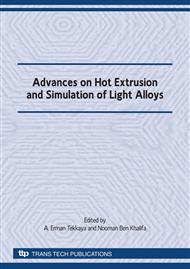[1]
N. Aravas, The analysis of void growth that leads to central bursts during extrusion, J. Mech. Phys. Solids, Vol. 34, (1986) pp : 55-79.
DOI: 10.1016/0022-5096(86)90005-0
Google Scholar
[2]
B. Kim, D-C Ko, The prediction of central burst defects in extrusion and wire drawing, Journal of Materials Processing Technology, Vol. 102, (1998) pp.19-24.
DOI: 10.1016/s0924-0136(99)00461-6
Google Scholar
[3]
K. Komori, Proposal ans use of a void model for the simulation of inner fracture defect in drawing Acta Materials, vol. 54, (2006), pp.4351-4364.
DOI: 10.1016/j.actamat.2006.05.027
Google Scholar
[4]
C. Labergere, P. Lestriez, K. Saanouni, A. Rassineux, Adaptive FEA Simulation of burst defects in cold extrusion with fully coupled elastoplastic constitutive equations, 12 international Conference Metalforming, Krakow, CD, (2008).
Google Scholar
[5]
J. Lemaitre , A course on Damage Machanics, Springer Verlag, Berlin, (1992).
Google Scholar
[6]
Mcallen P., Phelan P., Ductile fracture by central bursts in drawn 2011 aluminium wire, International Journal of Fracture, Springer edition, vol. 135, (2005) pp.19-33.
DOI: 10.1007/s10704-005-3470-5
Google Scholar
[7]
C. Mc Veigh, W.K. Liu, Prediction of central bursting during axisymmetric cold extrusion of a metal alloy containing particles, International Journal of Solid ans Structures, vol. 43, (2006), pp.3087-3105.
DOI: 10.1016/j.ijsolstr.2005.05.019
Google Scholar
[8]
K. Saanouni, J.L. Chaboche, Computational Damage Mechanics. Application to Metal Forming, Chapter 7 of the Volume 3: Numerical and Computational methods, (2003).
DOI: 10.1016/b0-08-043749-4/03072-x
Google Scholar
[9]
K. Saanouni, J.F. Mariage, A. Cherouat, P. Lestriez, Numerical prediction of discontinuous central bursting in axisymmetric forward extrusion by continuum damage mechanics, Computers and Structures, vol. 82, (2004) pp.2309-2332.
DOI: 10.1016/j.compstruc.2004.05.018
Google Scholar
[10]
Soyarslan C., E. Tekkaya, U. Akyuz, Application of Continuum Damage Mechanics in discontinuous crak formation: Forward extrusion chevron prediction, Z. Angew. Math. Mech. 88, No 6, (2008), pp.436-453.
DOI: 10.1002/zamm.200800013
Google Scholar
[11]
D. Umbrello, J. Hua, R. Shivpuri, Hardness-based flow stress and fracture models for numerical simulation of hard machining AISI52100 bearing, Materials Science and Engineering, vol 374, (2004), pp.90-100.
DOI: 10.1016/j.msea.2004.01.012
Google Scholar


